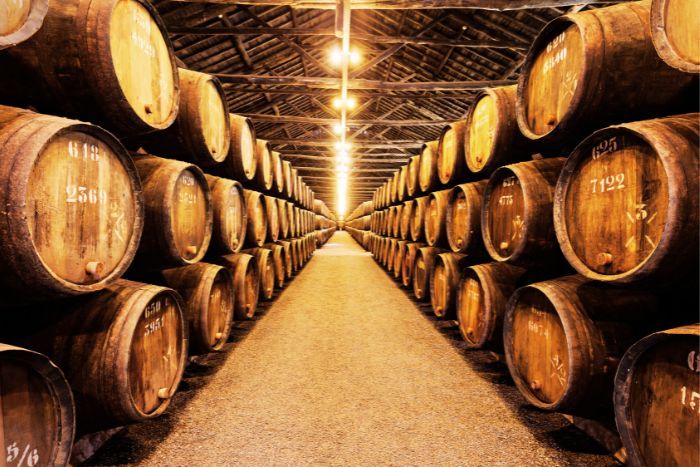The Scientific Process Behind Wine Ageing
Discover the science behind wine ageing: factors, chemical processes and techniques that improve its quality and value over time.

Wine ageing is an art and a science that has fascinated winemakers and wine lovers for centuries. At Vinissimus, we understand that the ageing process is crucial to developing the complex flavours and aromas that characterise a good wine.
In this post, we will explore the factors and chemical processes involved in wine ageing, and how they influence its quality and value.
History of Wine Ageing
Wine ageing has its roots in antiquity. Around 3000 BC, the Egyptians stored wine in clay amphorae sealed with resin, on the understanding that wine improved with time.
The Greeks and Romans adopted and perfected these techniques, using wooden barrels that not only facilitated transport but also improved the taste of the wine. The introduction of oak as a main material was an important milestone.
During the Middle Ages, monks preserved and improved these practices in monasteries, especially in regions such as Bordeaux and Burgundy.
In the 18th century, the demand for quality wines drove the improvement of ageing techniques. The port wine trade in England led to the use of glass and cork bottles, allowing for more controlled ageing.

In the 20th century, science and technology revolutionised wine ageing. Detailed studies on chemical processes were carried out and modern techniques such as micro-oxygenation were developed.
Today, wine ageing combines traditional methods with technological innovations, producing wines that can improve and evolve for decades. This history reflects the constant quest for perfection by winemakers and oenologists over the centuries.
Factors influencing the ageing of wine
Grape variety
Different grape varieties contribute unique characteristics that influence how a wine ages. For example, red grapes such as Cabernet Sauvignon and Tempranillo have tannins and anthocyanins that develop favourably over time, while white grapes such as Chardonnay can gain complexity in oak barrels.
Storage conditions
Temperature, humidity and lighting are critical factors in wine storage. Maintaining a constant temperature between 12-15°C and a relative humidity of 70-80% helps prevent premature oxidation and cork deterioration.
Light, especially ultraviolet light, can damage wine, so storage in dark places is recommended.
Type of container
The material of the container in which the wine is aged also plays an important role. Oak barrels are the most traditional and preferred, as they allow a micro-oxygenation that improves the structure of the wine and adds characteristic flavours such as vanilla and spices.

Stainless steel tanks, while not allowing the same interaction with air, are useful for certain styles of wine that require a fresher, fruitier profile.
Chemical processes during ageing
Oxidation and reduction
Oxidation and reduction are key reactions in wine ageing. Carefully controlled oxidation can develop complex aromas and flavours, while reduction helps to preserve the freshness of the wine.
Polymerisation reactions
During ageing, the tannins and anthocyanins present in red wine polymerise, which softens the tannins and stabilises the colour. This process contributes to the silky texture and deep colour of aged red wines.
Evolution of aroma compounds
Over time, the wine's aromatic compounds evolve, transforming primary fruit aromas into complex secondary and tertiary aromas. These can include notes of leather, tobacco, nuts and spices, enriching the sensory experience of the wine.
Importance of oak in ageing
Types of oak used
French and American oak are the most commonly used in barrel making. French oak contributes a finer texture and subtle flavours, while American oak imparts more pronounced notes of coconut and vanilla.

Methods of toasting barrels
The barrels are toasted inside before use. The degree of toasting (light, medium, heavy) affects the flavours and aromas transferred to the wine. A light toast can enhance notes of fresh fruit, while a heavy toast can add smoky and spicy flavours.
The role of oxygen
Micro-oxygenation
Micro-oxygenation is a controlled process that introduces small amounts of oxygen during ageing, improving the stability and complexity of the wine without causing excessive oxidation.
Oxygen control in barrels
Proper oxygen management is crucial to avoid wine deterioration. Barrels allow for natural micro-oxygenation, but it is essential to control oxygen exposure to maximise the benefits and minimise the risks.
Benefits of ageing
Wine ageing brings multiple benefits, from enhancing complexity to developing unique flavours and aromas. In addition, a well-aged wine can significantly increase its economic value, making it an attractive investment for collectors and wine lovers.
Conclusion
Scientific knowledge of wine ageing is fundamental to making high-quality wines. We invite all wine lovers to explore and appreciate the complexity and beauty that develops in each bottle over time.
FAQs
How long must a wine be envied to improve?
There is no standard time; some wines benefit from a few years, while others can take decades. It depends on the specific characteristics of each type of wine.
Are all wines suitable for ageing?
No, only certain types of wines, generally those with good acidity, structured tannins and flavour concentration, are designed to improve with age.
What chemical changes occur during ageing?
During this process, there are reactions such as oxidation, polymerization and esterification that transform the primary compounds into more complex and palatable ones.
How can I tell if a wine is ready to drink after ageing?
The best way is to test it periodically; if you notice a harmony between its components (acidity, tannins and aromas), you are likely ready to enjoy it.
___________
You May Be Also Interested in:
- Winemaking Process in Spain
- All you need to know about Sherry wines
- How to Lie Down Wine to Age It?
- Oak-aged white wines
- Magnum Wine Bottle and Large Wine Formats
- Wine Barrels: Types and Their Characteristics
- Volcanic wines